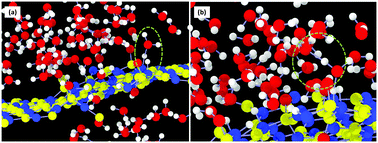ReaxFF reactive molecular dynamics simulations to study the interfacial dynamics between defective h-BN nanosheets and water nanodroplets†
Abstract
In this work, the authors have developed a reactive force field (ReaxFF) to investigate the effect of water molecules on the interfacial interactions with vacancy defective hexagonal boron nitride (h-BN) nanosheets by introducing parameters suitable for the B/N/O/H chemistry. Initially, molecular dynamics simulations were performed to validate the structural stability and hydrophobic nature of h-BN nanosheets. The water molecule dissociation mechanism in the vicinity of vacancy defective h-BN nanosheets was investigated, and it was shown that the terminal nitrogen and boron atoms bond with a hydrogen atom and hydroxyl group, respectively. Furthermore, it is predicted that the water molecules arrange themselves in layers when compressed in between two h-BN nanosheets, and the h-BN nanosheet fracture nucleates from the vacancy defect site. Simulations at elevated temperatures were carried out to explore the water molecule trajectory near the functionalized h-BN pores, and it was observed that the intermolecular hydrogen bonds lead to agglomeration of water molecules near these pores when the temperature was lowered to room temperature. The study was extended to observe the effect of pore sizes and temperatures on the contact angle made by a water nanodroplet on h-BN nanosheets, and it was concluded that the contact angle would be less at higher temperatures and larger pore sizes. This study provides important information for the use of h-BN nanosheets in nanodevices for water desalination and underwater applications, as these h-BN nanosheets possess the desired adsorption capability and structural stability.



 Please wait while we load your content...
Please wait while we load your content...